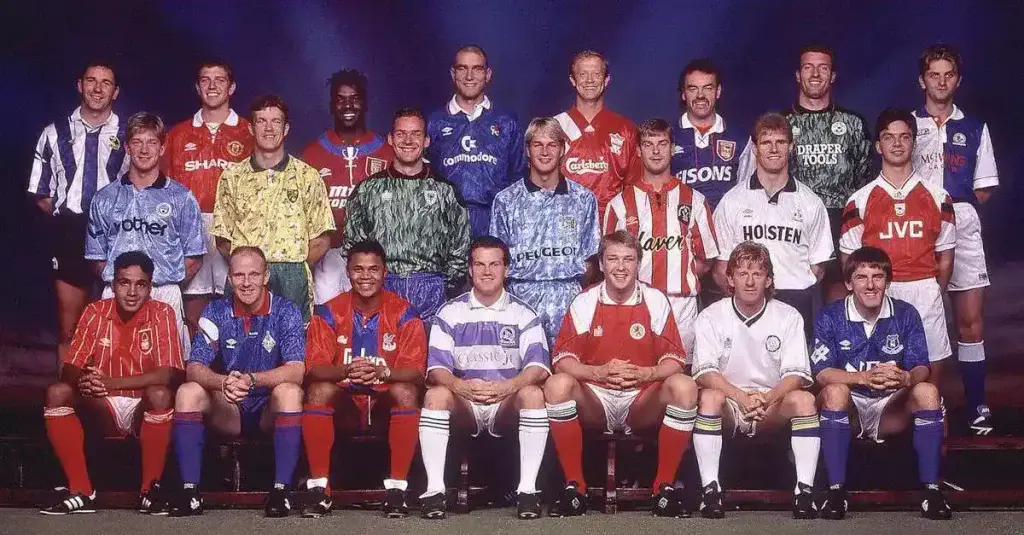English football history is a story of grit, glory, and transformation. From muddy village fields to billion-pound stadiums, it’s seen changes that shaped not just a game—but a culture. If you’ve ever wondered how a sport born in public schools turned into a global phenomenon watched by billions, you’re in for a deep, factual, and no-fluff read. This article tracks how football in England evolved over time, spotlights key turning points, and explains how it became a global powerhouse. Ready to understand how passion met professionalism? Let’s begin.
The Origins: Football Before It Was Football
Long before the Premier League existed, English football had humble roots. The earliest references to football date back to the 12th century. These early versions were unruly, often violent street games played between villages. With no standardized rules, anything went—kicking, throwing, and even wrestling were part of the action.
By the 19th century, things began to change. Public schools such as Eton and Harrow developed their own sets of rules. These efforts laid the groundwork for codification. In 1863, the Football Association (FA) was formed in London, which set the first unified set of rules. This split football from rugby permanently.
Key Facts:
- The FA was established on October 26, 1863.
- The first official football match under FA rules took place the same year.
- Cambridge Rules (1848) heavily influenced the modern game’s structure.
This stage in English football history was all about structure and identity. From chaos came order, and with order came growth.
Professionalism and the Birth of the Football League
The next turning point came in the late 19th century when football turned professional. Until the 1880s, players were strictly amateurs. But growing fan interest and financial backing led to clubs offering money to skilled players.
In 1885, the FA finally legalized professionalism. Just three years later, in 1888, the Football League was born. Founded by Aston Villa’s William McGregor, it featured 12 clubs including Preston North End, Wolverhampton Wanderers, and Blackburn Rovers.
Impact of the Football League:
- It created a structured competition format.
- Preston North End became the first “Invincibles” by winning the league unbeaten in 1888–89.
- Matchday attendance skyrocketed, with crowds exceeding 30,000 even in the early 1900s.
This era introduced club loyalty, rivalries, and weekend rituals. Football was no longer just a pastime—it was becoming a way of life.
The Early 20th Century: War, Struggles, and Football’s Resilience
The 20th century began with momentum, but two World Wars disrupted everything. During World War I (1914–1918), the Football League was suspended, and many players enlisted. Some clubs ceased operations entirely. A similar halt happened during World War II (1939–1945), with the league suspended from 1939 to 1946.
Despite this, football remained a symbol of hope. During wartime, unofficial matches and regional leagues kept spirits alive. Soldiers played games on foreign soil, boosting morale and strengthening national identity.
Wartime Football Highlights:
- Over 2,000 players served in World War I.
- Makeshift matches were held to raise funds for war efforts.
- After WWII, clubs like Manchester United and Arsenal helped revive competitive football.
This period in English football history tested the sport’s durability. Yet, even bombs couldn’t crush its popularity.
Post-War Boom: Football Becomes a National Obsession
When league football returned after World War II, the appetite was huge. Stadiums filled up fast. Football was affordable, entertaining, and felt like home to working-class Britain. Clubs began building legacies. The FA Cup regained its importance. Players like Stanley Matthews, Tom Finney, and Nat Lofthouse became household names.
In 1953, the “Matthews Final” (Blackpool vs. Bolton) saw Sir Stanley Matthews finally win the FA Cup at age 38. It was a landmark moment that symbolized the magic of the sport.
Post-War Milestones:
- Record attendance of 126,047 at the 1953 FA Cup Final.
- First live football match on British television aired in 1937, resumed in the 1950s.
- Football pools and radio commentary surged in popularity.
Football was more than a game. It united communities, gave people heroes, and shaped the week around Saturday fixtures.
The 1966 World Cup: England’s Greatest Triumph
Ask any English fan, and 1966 will still bring goosebumps. England hosted—and won—the FIFA World Cup, defeating West Germany 4–2 in extra time. Geoff Hurst scored a historic hat-trick, the only one in a World Cup final to date.
This victory put England firmly on the football map. It was no longer just the birthplace of football—it was its master, at least for that moment.
Key Takeaways from 1966:
- Wembley hosted the final in front of 96,924 fans.
- England, led by manager Alf Ramsey, didn’t lose a single match in the tournament.
- The phrase “They think it’s all over—it is now!” became iconic.
The win transformed the global image of English football and elevated expectations forever.
The Dark Decades: Hooliganism and Decline (1970s–1980s)
While the 60s were glorious, the 70s and 80s exposed some of football’s darkest chapters. Stadiums were crumbling, racism was widespread, and hooliganism threatened the very core of the sport. English clubs faced violence from both fans and poor infrastructure. The football experience became dangerous.
Attendance declined, and families stayed away. Clubs struggled financially. The sport seemed stuck in a rut, plagued by outdated facilities and toxic fan behavior.
Major Incidents:
- Heysel Disaster (1985): 39 fans died during a European Cup final involving Liverpool and Juventus.
- Bradford City Fire (1985): 56 people died due to a stand fire at Valley Parade.
- Hillsborough Disaster (1989): 97 fans lost their lives due to overcrowding and poor crowd control.
These tragedies pushed football authorities to take drastic measures. The game’s reputation hit rock bottom, forcing change.
The Formation of the Premier League: A New Era (1992 Onwards)
In 1992, English football history changed forever. Top clubs broke away from the Football League to form the Premier League. Backed by lucrative TV rights deals—initially with BSkyB—this move revolutionized the sport.
The aim was to modernize football, improve stadiums, increase commercial income, and bring in top international talent. It worked. The Premier League exploded in popularity, attracting sponsors, global viewership, and billionaire investors.
Key Transformations:
- Revenue soared from £170 million (1992) to over £5 billion annually today.
- Clubs invested in modern stadiums, training facilities, and youth academies.
- Superstars like Eric Cantona, Dennis Bergkamp, and Gianfranco Zola became league icons.
This was the rebirth. Football wasn’t just back—it was thriving like never before.
Global Appeal and Commercial Boom
The Premier League’s global strategy turned English football into a global export. Broadcasts reached over 200 countries. Clubs like Manchester United, Arsenal, and Liverpool developed global fanbases. Merchandise, digital media, and international tours made clubs household names far from English shores.
Top international players flocked to England. Sponsorships poured in. TV rights deals continued to grow at breakneck pace.
Fast Facts:
- Over 3.2 billion people watched the 2022–23 Premier League season.
- Manchester United alone has over 650 million fans worldwide.
- Asian and African markets became vital for league expansion.
English football had become a brand—a giant, unstoppable force of entertainment and money.
Technology, Innovation, and Modernization
Today’s English football is smarter, faster, and more analytical. Clubs invest millions in sports science, nutrition, data analytics, and tactical planning. VAR (Video Assistant Referee) changed the way decisions are made. Goal-line technology ensures accuracy, and player tracking systems provide real-time data.
Training centers resemble tech labs. Coaches use drones, VR, and biometric feedback. Football isn’t just played—it’s engineered.
Modern Upgrades:
- Hawk-Eye goal-line tech implemented in 2013.
- VAR introduced in the Premier League in 2019.
- AI and wearable tech help monitor player fatigue, injury risk, and performance.
While fans sometimes resist change, these innovations are shaping the next generation of English football.
Pros & Cons of Modern English Football
Pros:
- Global Reach: Fans from every continent watch the Premier League.
- Financial Stability: Clubs now operate as powerful commercial entities.
- High Quality: The best players and managers in the world come to England.
- Infrastructure: Modern stadiums offer safe, inclusive environments.
- Innovation: Use of data, fitness science, and tech enhances gameplay.
Cons:
- Ticket Prices: Watching a game live is costly for many working-class fans.
- Over-Commercialization: Some argue that branding has overshadowed tradition.
- Foreign Ownership: Club identities risk dilution due to global investors.
- Fixture Congestion: More matches mean player fatigue and increased injuries.
The growth is real—but so are the challenges. Balancing success with soul remains a key issue.
FAQs: Understanding English Football History
Who started football in England?
The roots date back to medieval times, but public schools codified it in the 1800s. The Football Association was formed in 1863.
What was the first English football league?
The Football League, launched in 1888, was the world’s first organized football competition.
Why was the Premier League formed?
To capitalize on commercial revenue, improve competitiveness, and modernize football in England.
How has technology impacted football?
Technology has brought fairness, improved player safety, and helped optimize team performance.
Will English football continue to grow?
Yes. With global fans, huge investments, and evolving strategies, it shows no signs of slowing down.
Conclusion
English football history reflects more than goals and trophies—it tells a story of resilience, ambition, and transformation. From muddy pitches and hand-written rulebooks to tech-laden stadiums and billion-pound clubs, the sport has journeyed far. It has faced wars, scandals, and crises, yet always bounced back stronger.
What lies ahead? That’s up to clubs, fans, and future talent. But one thing is certain—the world will be watching.
Liked this article? Drop a comment, share with your football-loving friends, or tell us your favorite English football moment. Let’s keep the passion alive.










